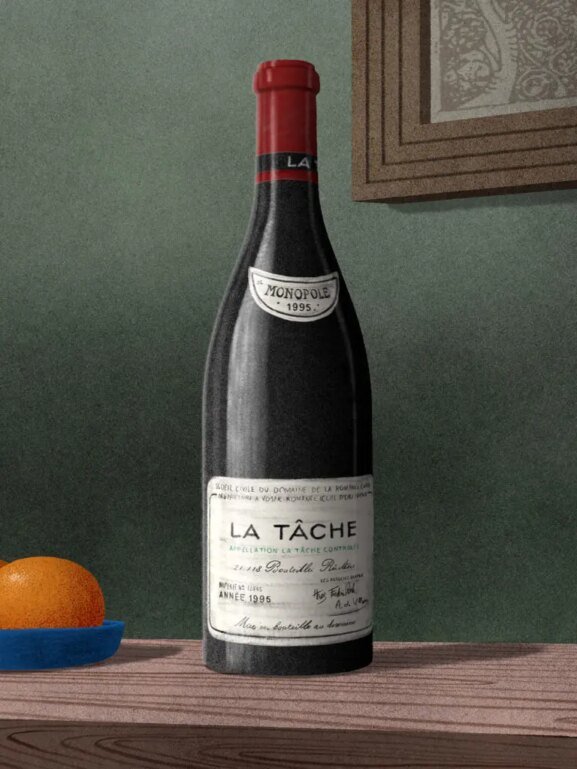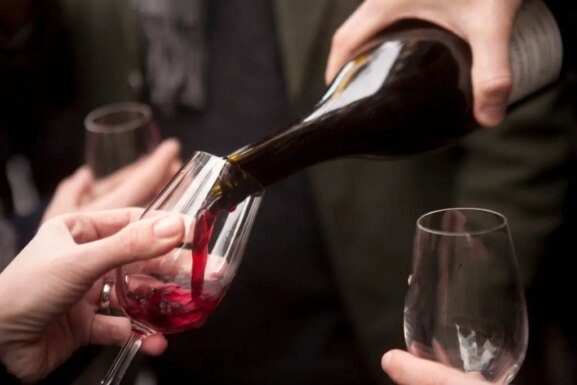Chinese Wine Is on the Rise in America—Tariffs Be Damned
It’s not easy to surprise New Yorkers with something completely new, but one summer night at Cellar 36, a natural wine bar in Chinatown, bartenders did just that. Guests sipped amber-hued muscats, pét-nats fizzed with the aroma of tea, and a range of Chinese wines that had never been poured in New York City.
Winemaking in China dates back nearly 7,000 years, with archaeological evidence of grape seeds found in Jiahu, Henan, but Chinese wine is only now gaining a reputation for its range and variety. Thanks to a new generation of winemakers producing bottles with an eye for technique and experimentation, Chinese wines are poised to show up on more American wine lists.
In New York, where French, Italian, and Californian bottles typically dominate, Camden Hauge, the New Jersey-born founder of wine importer China Wine Club, is spotlighting contemporary, low-intervention wines from all over China. Her interest in Chinese wine first piqued in 2017 when, after living in Shanghai for five years, she opened Bird, one of just two natural wine bars in the city at the time.
Hauge initially sourced wines from women-owned and small producers from all over the world. But one day, she began questioning why it was so hard to find locally produced wines, even in a booming metropolis like Shanghai. “I didn’t understand why there wasn’t a higher level of wine,” she says.
Hoping to discover more, she began prolifically tasting Chinese wines, visiting vineyards, and hosting wine festivals, and soon became obsessed with sharing that enthusiasm. “This [wine] is of quality. This is in our backyard,” she says. “But why are we not drinking our own domestic wine?”
The New Generation of Chinese Winemakers
In China, most people have long favored beverages such as tea, beer, and baijiu, a clear Chinese spirit made from sorghum. The exception was a small, elite circle of collectors who snapped up luxury imports—almost exclusively from Bordeaux—after the country opened up in the late 1970s; it’s an obsession with prestige labels that continues today.
Hoping to replicate that prestige in China, foreign investors like Rémy Martin and LVMH planted French-varietal vineyards in Hebei, Shandong, and Shanxi in the last forty years, and produced wines with lofty price tags. But these bottles were far beyond the reach of ordinary drinkers. For most working-class families, including Chinese people immigrating to America, table wine meant mass-market labels like Great Wall, a Cabernet Sauvignon-dominant blend that’s often likened to the Yellow Tail or Barefoot of China.
In the last decade or so, a new generation of Chinese winemakers has emerged, slowly chipping away at the narrative that Chinese wines are ostentatious or one-dimensional. To build her portfolio, Hauge sought out these young winemakers who had demonstrated both technical excellence and an intrepid eye for experimentation. Some had previously worked as sommeliers and wine educators in China, while others had trained with experienced winemakers in France and Australia.
The turning point was COVID-19. “A lot of these winemakers came back to China or visited Ningxia and realized there was so much potential here,” Hauge says.

// Create the element
var script_68c9b53b0c6ba = document.createElement(“script”);
script_68c9b53b0c6ba.innerHTML = `
window.googletag = window.googletag || {cmd: []};
googletag.cmd.push(function() {
var adType = “leaderboard”;
var mapping;
var lbmapping = googletag.sizeMapping()
.addSize([1024, 0], [[970, 250], [970, 90], [1, 1], [728, 90]])
.addSize([728, 0], [[728, 90], [1, 1]])
.addSize([320, 0], [[1, 1], [300, 50], [300, 100], [320, 50], [320, 100]])
.addSize([0, 0], [[1, 1], [320, 50]])
.build();; // Size mapping for leaderboard ads
var medrecmapping = googletag.sizeMapping()
.addSize([1024, 0], [[300, 600],[300, 250]])
.addSize([728, 0], [300, 250])
.addSize([320, 0], [[1, 1],[300, 250]])
.addSize([0, 0], [[1, 1], [300, 250]])
.build(); // Size mapping for med rectengle ads
if(‘/39808611/article_page/article_leaderboard_1’ == ‘/39808611/article_page/article_leaderboard_1’
|| ‘/39808611/article_page/article_leaderboard_1’ == ‘/39808611/article_page/article_leaderboard_2’
|| ‘/39808611/article_page/article_leaderboard_1’ == ‘/39808611/article_page/article_leaderboard_3’) {
mapping = googletag.sizeMapping()
.addSize([1920, 0], [[728, 90]]) // >= 1920px
.addSize([1440, 0], [[728, 90]]) // 1440px-1919px
.addSize([730, 0], [[300, 250]]) // 730px-1439px
.addSize([0, 0], [[320, 100], [320, 50], [300, 100], [300, 50], [300, 250]]) // Up to 729px
.build();
} else {
mapping = adType == ‘leaderboard’ ? lbmapping : medrecmapping;
}
googletag.defineSlot(‘/39808611/article_page/article_leaderboard_1’, [],
‘div-gpt-ad-68c9b53b0c6ba’).addService(googletag.pubads()).defineSizeMapping(mapping);
googletag.pubads().enableSingleRequest();
googletag.pubads().collapseEmptyDivs();
googletag.display(‘div-gpt-ad-68c9b53b0c6ba’);
});
`;
// Append the script to the body
document.body.appendChild(script_68c9b53b0c6ba);
Ian Dai, the former wine buyer for Amazon and a Chinese winemaker, wanted to explore how Chinese terroir could be captured in a bottle. In 2017, he launched a wine label, Xiaopu; since then, he has produced wine in over six different provinces. Emma Gao, the head of Ningxia-based vineyard Silver Heights, trained in Bordeaux and ages her wines in terracotta amphora. Meanwhile, Yuchen Luo heads FARMentation, a fruit-based project that produces effervescent tea pét-nats in Yunnan, while Shofang Hu and her husband, Liwei Li, rely on old vines, some over 80 years old, in Hebei to make their core cuvée: a skin-contact Black Muscat.
If Shanghai’s openness sparked Hauge’s curiosity for Chinese wine, New York City offered the perfect launchpad for China Wine Club, which is bringing bottles to some of the city’s most popular wine shops, bars, and restaurants, including institutions like Gramercy Tavern, Sichuan hotspot Birds of a Feather, and popular wine bars such as Lei and Cellar 36. “There’s an open-mindedness about New Yorkers. It almost surges on competition,” she says. “If you want to try something before your friends, you’re like, ‘You haven’t tried this wine yet.’”

Despite Tariffs, Momentum in Manhattan
The launch of China Wine Club happened just as President Donald Trump announced tariffs on Chinese goods, but Hauge remains optimistic: With no prior Chinese wine market in the U.S., there was no baseline for price adjustments. Her producers, too, have been willing to absorb the risk: “They value having the wine in America more than they do keeping their margins.”
When selecting the wines for her first shipments, Hauge chose six producers with bottles that would surprise drinkers who might not know about China’s geography and terroir.
“Instead of bringing classic Bordeaux blends and single varietals, I wanted people to have no basis for comparison,” she says. “They would taste blind and be able to assess: Do I like this?” Her second shipment, set to arrive later this year, will feature more traditional styles, including Bordeaux varieties and huang jiu, or Chinese yellow wine.

Annie Shi, owner of Lei, a Chinese-American wine bar in Manhattan’s Chinatown, wanted to include Chinese wine on her opening 500-bottle list. After tasting through Hauge’s portfolio, Shi knew how to guide diners through the wines and help her chef pair them with food. “There are definitely bottles that I was like, ‘Wow, this is really funky,’” Shi says. “In terms of technique, it’s extremely experimental, so it’s been fun to see that transition.”
Matt Turner, Lei’s wine director, had never encountered Chinese wine beyond the popular Bordeaux blends. Now, he’s constantly fielding questions from diners who order the wine for the first time. “Hilariously, they never ask us, where in China?” says Turner. “It’s a very large country with different zones.” Whatever Turner and his team are saying, it’s working. Lei has sold at least one bottle of Chinese wine every day since they opened.

Meanwhile, Hauge continues her tour-de-China around New York with events almost every month. She co-hosted a dinner at Fujianese restaurant Nin Hao, conducted a blind tasting against French wine at Astor Wines & Spirits, and even poured qinghong, a Fujianese rice wine, from homebrewer Allen Cao. Showcasing the diversity of China—and all its wine—is part of the plan. “We’re centered on grape wine for now,” she says. But Hauge has grander ambitions to expand the portfolio: She wants China Wine Club to eventually include the spectrum of Chinese alcohol.
// Create the element
var script_68c9b53b0ceae = document.createElement(“script”);
script_68c9b53b0ceae.innerHTML = `
window.googletag = window.googletag || {cmd: []};
googletag.cmd.push(function() {
var adType = “leaderboard”;
var mapping;
var lbmapping = googletag.sizeMapping()
.addSize([1024, 0], [[970, 250], [970, 90], [1, 1], [728, 90]])
.addSize([728, 0], [[728, 90], [1, 1]])
.addSize([320, 0], [[1, 1], [300, 50], [300, 100], [320, 50], [320, 100]])
.addSize([0, 0], [[1, 1], [320, 50]])
.build();; // Size mapping for leaderboard ads
var medrecmapping = googletag.sizeMapping()
.addSize([1024, 0], [[300, 600],[300, 250]])
.addSize([728, 0], [300, 250])
.addSize([320, 0], [[1, 1],[300, 250]])
.addSize([0, 0], [[1, 1], [300, 250]])
.build(); // Size mapping for med rectengle ads
if(‘/39808611/article_page/article_leaderboard_2’ == ‘/39808611/article_page/article_leaderboard_1’
|| ‘/39808611/article_page/article_leaderboard_2’ == ‘/39808611/article_page/article_leaderboard_2’
|| ‘/39808611/article_page/article_leaderboard_2’ == ‘/39808611/article_page/article_leaderboard_3’) {
mapping = googletag.sizeMapping()
.addSize([1920, 0], [[728, 90]]) // >= 1920px
.addSize([1440, 0], [[728, 90]]) // 1440px-1919px
.addSize([730, 0], [[300, 250]]) // 730px-1439px
.addSize([0, 0], [[320, 100], [320, 50], [300, 100], [300, 50], [300, 250]]) // Up to 729px
.build();
} else {
mapping = adType == ‘leaderboard’ ? lbmapping : medrecmapping;
}
googletag.defineSlot(‘/39808611/article_page/article_leaderboard_2’, [],
‘div-gpt-ad-68c9b53b0ceae’).addService(googletag.pubads()).defineSizeMapping(mapping);
googletag.pubads().enableSingleRequest();
googletag.pubads().collapseEmptyDivs();
googletag.display(‘div-gpt-ad-68c9b53b0ceae’);
});
`;
// Append the script to the body
document.body.appendChild(script_68c9b53b0ceae);
Back in China, winemakers like Dai are hearing feedback from Americans for the first time. He only hopes this curiosity continues to grow. “I want people to leave their prejudices at the door for this region,” he says. “If you like it, drink more, but if you don’t, try something else. The point is, we have a lot of diversity here.”
More Asian Wine Coverage
- How India’s wine culture is shifting dramatically.
- Get to know Thailand’s blossoming wine scene.
- Here’s why Bhutan’s first-ever domestic wine is such a big deal.
- Often overlooked, flower wine is in full bloom around the world.
- Is India the next great nation of wine lovers?

From the Shop
Find Your Wine a Home
Our selection of red wine glasses is the best way to enjoy the wine’s subtle aromas and bright flavors.
The post Chinese Wine Is on the Rise in America—Tariffs Be Damned appeared first on Wine Enthusiast.


